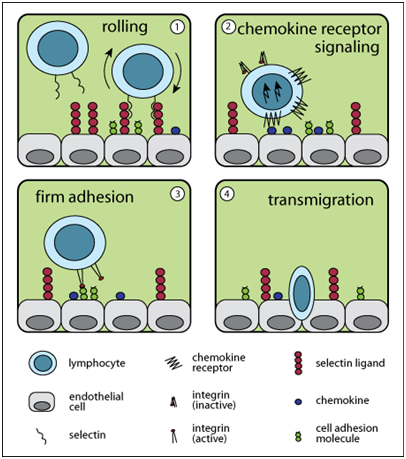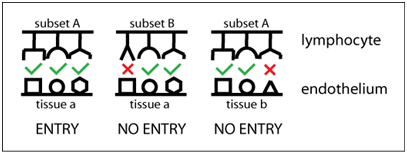BiteSized Immunology: Systems & Processes

T Lymphocyte Transmigration
T lymphocyte migration occurs via a multistep pathway
Transmigration, or diapedesis, is the process by which T lymphocytes migrate across venular blood vessel walls to enter various tissues and organs. The capacity to transmigrate is of critical importance for the T lymphocyte at all life stages, from entry of T-cell precursors into the thymus for T-cell development to entry of naïve T cells into lymph nodes for activation, or migration of effector T cells into tissues to fight infections. Transmigration occurs via a multi-step pathway including lymphocyte rolling, signalling, firm adhesion and transmigration (see below and Figure 1). Each step is regulated by interactions between adhesion molecules or chemokine receptors expressed on the lymphocyte surface and their ligands expressed on endothelial cells lining the vascular wall.

- Lymphocyte rolling. Lymphocyte rolling initiates the contact between lymphocyte and the endothelium. It is mediated by repeated bind-release events between selectins and their ligands. During rolling, chemokines displayed on the endothelial cell can interact with chemokine receptors on the lymphocyte surface.
- Signalling. The interaction between a chemokine and its chemokine receptor leads to an intracellular signalling event, which in turn activates adhesion molecules of the integrin family.
- Firm adhesion. Following activation integrins display high affinity binding sites which interact with cell adhesion molecules (CAMs) on the vascular wall, resulting in lymphocyte halt and firm adhesion.
- Transmigration. The process of transmigration is less well characterised compared to the other steps, especially with a focus on T lymphocytes, however some information is known from experiments with other cell types, e.g. neutrophils.
To find a suitable position for crossing the endothelium, the firmly adhered leukocytes crawl across the endothelial surface, a process mediated by integrins. Transmigration can occur either by migration through the junction between adjacent endothelial cells or via a transcellular channel through a single endothelial cell. Leukocyte transmigration is thought to involve several molecules, including PECAM1, JAM-A, -B and -C, ICAM1, ICAM2 and CD99.
T lymphocyte transmigration can be tissue-specific
Transmigration does not occur randomly, but is tightly regulated so that T lymphocytes can only enter into specific tissues. This can occur since venules in different tissues each display unique combinations of adhesion molecules and chemokine ligands. Therefore, only T cells expressing the correct combination of chemokine receptors and adhesion molecules will gain entry into each tissue (see Figure 2). For example, the chemokine CCL25 and the CAM MAdCAM-1 are involved in recruitment of T cells that express the chemokine receptor CCR9 and the integrin a4b7 to the small intestinal mucosa.

© The copyright for this work resides with the author.
